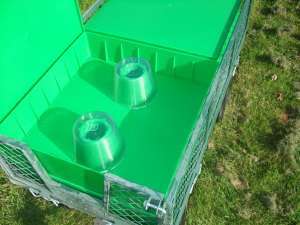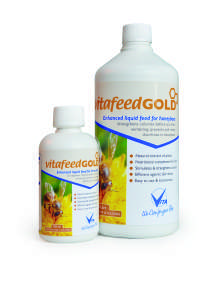And you thought the bees were going to provide you with food? Well, hopefully they will, but in “bad” years you will be feeding them – possibly throughout the year. The following how-to is primarily based on the National Bee Unit guide to feeding bees and covers sugar, pollen and water feeding.
Keeping It As Natural As Possible
- I am not aware of any scientific evidence yet, but surely their own honey has got to be better than feeding them with refined sugar. Leave the bees with enough honey to last them through the year. This means leaving your 14×12, brood and a half or double brood box well alone and not be tempted to harvest honey from it (they will need 20Kg of stores to get them through from September to March)
- The best way to guarantee that bees have enough pollen is to ensure there are adequate and round-the-year pollen-bearing plants close to the hives
- Ensure that the bees have access to a clean water supply
Other Tips
- Avoid feeding honey as it carries the risk of spreading bee diseases and the odour increases the likelihood of robbing
- Avoid spilling or leaving syrup open to bees in the apiary
- Take care to avoid robbing
- Now is the time to make sure your hive is level so that all the syrup is available to the bees
When To Feed
- When a colony is short of stores and there is no or little nectar flow. This can occur at any time of year.
- When you have combined 2 hives
- When you have hived a swarm
Types Of Feeders
There are three basic types of feeder used to feed sugar syrup to honey bee colonies.
Rapid Feeders
These feeders comprise of a tray which is placed over the hive to which bees have access from below by means of a hole or slot arranged to stop them drowning. Versions known as Miller or Ashforth are made to the same dimensions of the hive and are placed directly on top of the brood frames. They can feed up to about 10L at a time. Rapid feeders are ideal for feeding bees in Spring till Autumn but are of no use in cold conditions. When filling rapid feeders trickle a small quantity of the syrup down the side of the hole or slot to create a trail for bees to follow.
I use Jumbo Rapid Feeders as in the photo below. To read more about this particular feeder follow a link at the end of this page.
Contact Feeders
This is a plastic bucket with a lid fitted with a gauze centre section. The bucket is filled with sugar syrup and then inverted over an empty container to catch the small amount of syrup that will pass through the gauze before atmospheric pressure in the bucket drops thus holding the syrup in the feeder. It is then placed on the hive with the gauze patch over the crown board feeder hole. An empty brood box or super will be needed to support the hive roof. Contact feeders are generally more accessible to bees in cool weather conditions so are more effective for emergency feeding and Spring feeding.
The types of emergency I usually have need rapid feeding! And I am a bit afraid of relying on atmospheric pressure to stop the syrup pouring out due to gravitational pull.
Frame Feeders
These are containers that look like a brood frame with a slot at the top and have a float inside to prevent bees drowning. They are filled by pouring prepared syrup through the slot. Typically they are used to supplement the food and replace a frame within the brood box. In the UK they are mostly used for keeping nuclei ‘topped up’.
Sugar Syrup Recipe
Basic ingredients: White granulated sugar, water
Warning – Do not use brown or raw sugars as they contain impurities.
Thick Sugar Syrup: 1 Kg of granulated sugar to 630 ml of water (2 lb sugar to 1 pt of water)
Thin Sugar Syrup: 1 Kg of granulated sugar to 1L of water (2 lb sugar to 2 pt of water)
There is no need to boil the mixture but heating the water helps. Stir regularly to dissolve all the sugar. When fully dissolved the mixture is clear and a very pale straw colour.
If syrup is stored for any length of time then a black fungal growth may appear. This can be prevented by adding a little thymol. Thymol does not dissolve readily in water but a solution can be made up in a small sealable bottle. Fill it to one third with thymol crystals* and top the bottle up with surgical spirit. Add 2.5 ml. of this solution to 4.5 l. of sugar syrup or half a teaspoon to a gallon of syrup.
I use 30lb honey buckets to mix and serve the syrup.
Feed Enhancers
A really interesting area is feed enhancers which have claimed beneficial properties such as reducing Nosema, varroa and chalkbrood and can be added to the syrups described above. Enhancers include VitaFeed Gold* and VitaFeed Green produced by Vita, who also make the varroa treatments Apiguard and Apistan.
Where’s the evidence of the benefits I hear you ask? Field tests by Vita have shown a positive impact and a survey in the USA in 2014 undertaken by the Bee Informed Partnership (which represents 564,522 colonies, 21.7% of the USA’s 2.6 million colonies) focussed on over-wintering losses and the effect of honeybee treatments or lack of them. The results of using VitaFeed Green and VitaFeed Gold were inconclusive because of the very small sample size (14 respondents using Vita Feed Gold). However, the raw data suggested fewer losses as a result of using the feeds in 2013. Vita expect that the wider availability of their products in 2014 will show a conclusive and beneficial result in future surveys.
* The VitaFeed Gold link was paid for.
Bee Fondant Recipe
Bee fondant is best purchased from a bee or catering supplier (look online) as consistency tends to be variable when home made.
Ingredients:
- 4 parts granulated sugar
- 1 part water
- 1 Teaspoon White vinegar
Instructions:
- Pour sugar, water and vinegar into saucepan and bring to the boil stirring constantly
- Cover and gently boil for 5 minutes
- Remove lid and check temperature with cooking thermometer, continue to boil with lid off until temperature reaches 112C
- Remove from heat and cool to 93C
- Whip with mixer (preferably electric) until mixture begins to turn white and creamy with air bubbles
- Pour into shallow setting pans
- Allow to cool
Feeding A Swarm
When you hive a swarm, feed them the Thin Sugar Syrop.
Feeding Bees In Spring
If bees are short of stores at the Spring inspection then feed Thin Sugar Syrup.
Feeding Bees In Summer
If bees are short of stores during the Summer then feed Thin Sugar Syrup.
Feeding Bees In Autumn
If you harvest your honey in late July or early August, this gives the bees the opportunity to make their own winter stores.
September/early October is the time of year to feed Thick Sugar Syrup to ensure that honey bees have sufficient stores to last them the Winter. Feeding is done after the honey crop has been removed and whilst the colony is still strong, warm enough for bees to move up into the feeder, able to take syrup down, invert and store it properly in the comb.
Earlier feeding tends to be converted into brood so unless there is a risk of starvation wait until September.
I fed my bees too late when I found they had starved by the 18th September: link to story below. My lesson was that I need to read the comb better and feed in preference to using Apiguard if required. I think this is more likely with a new colony as opposed to an established one.
An average honeybee colony requires about 20 kg of stores. A British Standard brood frame, when full of honey contains about 2.5 kg so assess the existing colony stores and feed the required balance using sugar syrup. A 14×12 frames contains about 3.75Kg. Hence you need 8 (or 6) frames of honey.
Feeding at the time of some varroacide applications, usually those containing essential oils, is discouraged as this may increase robbing risks.
Note: 1Kg of sugar will create 1.25Kg of stores in the brood box.
Feeding Bees In Winter
If bees are short of stores in the winter and likely to starve then bee candy (bakers fondant) is placed over the crown board feed hole. The crown board may need turning in order to position a feed hole over the bee cluster. Bees require water, often taken as condensation within the hive, to make use of candy.
Emergency Feeding
In extreme cases when bees are starving spray them with a Thin Sugar Syrup solution and fill an empty comb with sugar syrup. This can be done by pouring the syrup into the cells slowly by using a squeezy bottle, e.g. a cleansed washing up fluid bottle, filled with sugar syrup. When filled, place the comb adjacent to the bees.
Feeding & Robbing
Care should be taken to prevent robbing. Tips:
- Best to feed in the evening
- Reduce the hive entrance with an entrance block
Watch for signs of robbing – bees fighting and bees trying to enter a hive without meeting the guards. If robbing starts reduce the entrance to one bee space using an entrance block and/or grass. This enables guard bees to protect the colony more efficiently. Placing a sheet of glass in front of the hive entrance so that bees have to go around the sides for access can also help. Alternatively, move the besieged colony to another apiary.
Feeding Pollen
The best way to guarantee that bees have enough pollen is to ensure there are adequate pollen-bearing plants close to the bees.
If you find their pollen stores are insufficient then feed a pollen substitute, pollen patty or pollen collected during the previous season.
Pollen can transmit bee disease so only collect it from a strong and disease free colony using a suitable pollen trap. Do not leave the trap on the hive all the time, as over an extended period it will deplete the colony of pollen. Avoid collecting during major honey flows. Pollen collected from one hive will be adequate to feed at least 50 hives.
Avoid using other beekeepers pollen.
The easiest way to store pollen is to put it into paper or plastic bags and store it in a deep freeze at -18°C. When defrosted use immediately.
Fresh or freshly thawed pollen can be fed to a colony by placing it in a shallow dish close to the feed hole.
Pollen substitutes can be purchased from a suitable commercial source.
When feeding substitutes follow the suppliers recommendations.
If bees do not have natural water supplies, then provide a supply by using a water feeder which can be bought and adapted from equipment suppliers.Feeding Water
If making your own water feeder remember that it is the natural inclination of bees to suck up moisture from a wet surface such as soil, sand or brick rather than from an open water surface. An area of about 75 cm² per colony is required. Do not permit the moisture to become stagnant. The landing area needs to be greater than the watering area.
Bees have a preference for water that is warmer than 18°C. When first supplying water, add a little salt to encourage the bees to use it




Δεν υπάρχουν σχόλια:
Δημοσίευση σχολίου